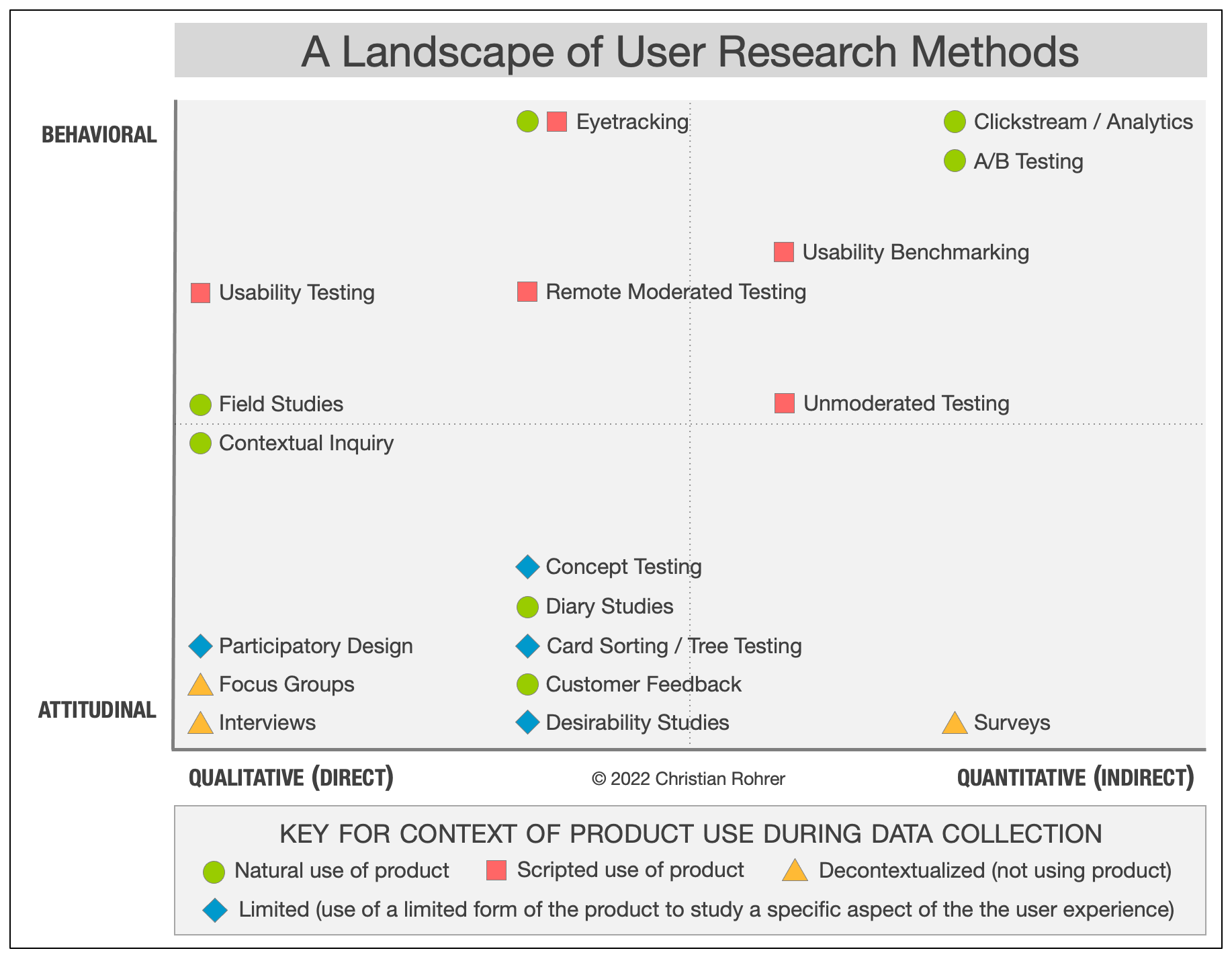User Research
User research is needed to directly involve (future) customers and, thus, help product teams craft a strategy that ensures that a built product fits users’ needs.
Types of User Research
On a fairly abstract level, user research methods can be classified in a 2×2 grid based on two dimensions:

Qualitative vs. Quantitative User Research
Attitudinal vs. Behavioral User Research
A More Extensive Overview
There exists a large variety of many different research methods along this 2×2 grid some of which will be discussed below.

User interviews will be covered in more detail below. Quickly sketching some other methods from that chart:
- In focus groups, a small number of people are selected based on shared interests and characteristics (e.g. the same job-to-be-don, see below) and then participate in a discussion, typically with a moderator. The objective is for the participants to share their opinions, viewpoints, and experiences from which the researcher can gather critical insights on a subject. Focus groups are about what users say and what their motivations are — hence fall into the qualitative & attitudinal sectors.
- During usability labs, users interact with a product or system in a controlled environment. Typically, the users are asked to perform a sequence of tasks and encouraged to think loud so that researchers watching the users can see and hear what they are thinking, where they struggle, and when they are surprised. It’s a direct observation of the behavior of users and, hence, qualitative & behavioral methods even though some quantitative aspects are sometimes addressed as well, e.g. when measuring the time taken to complete a task. See also Usability Testing.
- A/B testing, sometimes also referred to as split-run testing, is a very simple and popular method to compare two variants of a product. Typically, both variants are the same except for one variation which is expected to have an impact on the behavior of users. By randomly displaying one of the variants to a large number of users and measuring their engagement, the better-performing variant can be determined. A typical example would be to A/B test buttons or a call to action on a landing page to improve conversion rates.
- Click path analysis, click-streams, and — more generally — product analytics relates to tracing the behavior of users and their sequence of interactions into some kind of log file in order to understand the user journey, identify common paths and see where users are getting stuck. Apart from privacy concerns, this method requires a large number of homogeneous users with comparable JTBD.
Mission Briefing
- Based on facts and data, what is the context of the current project in terms of the current situation of the market and the product?
- What is the intention of the initiative, both in terms of supporting the product strategy as well as in having an impact on the lives of customers?
- What are the expected outcomes of the project?
- What are the boundaries that serve as guardrails, also what is scoped out explicitly?
User Interviews
Finally, let’s take a closer look at user interviews as a method of attitudinal, qualitative user research — including some useful tools and frameworks for these.
In such an interview, a researcher will ask one user questions about a specific topic of interest with the overall goal of learning how that topic is currently dealt with by users. Different to focus groups (see above), only one user is interviewed here by a UX researcher who may or may not be accompanied by other observers — e.g. to achieve a broad understanding of the problem area, pains, and gains, it is recommended that parts of the team are involved as well, and be it only as passive observers.
- Have a clear goal. A user interview is not about small talk but rather aims at building the optimal experience for a specific task. This objective has to be well-defined and aligned with stakeholders.
- Make the user feel comfortable. In order to have an open and honest conversation, people need to feel secure and relaxed. So use a convenient environment, connect with the user even before the actual interview, listen actively, and do not interrupt. Instead, repeat and confirm statements by the user.
- Be prepared. With questions and tasks for the user to conduct. Keep questions open without leading the user.
- Provide feedback. Thank the user and let them know about the next steps.
Further Reading

User Interviews: How, When, and Why to Conduct Them
User interviews have become a popular technique for getting user feedback, mainly because they are fast and easy. Use them to learn about users’ perceptions of your design, not about its usability.

How to Conduct User Interviews
The guide to discovering your product’s North Star.
